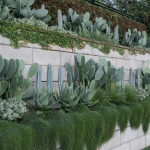Are you looking for landscaping ideas to hide a basement wall? Concealing an unsightly basement wall can be a challenge, but with the right landscaping, you can achieve a seamless and attractive exterior for your home. In this article, we will explore various creative and effective landscaping solutions to camouflage your basement wall and enhance the overall look of your outdoor space.
When it comes to improving the appearance of your home’s exterior, landscaping plays a crucial role. Not only does it add visual appeal, but it also helps create a cohesive and harmonious outdoor environment. With the right selection of plants, hardscaping elements, and natural screening, you can effectively conceal a basement wall while adding beauty and dimension to your yard.
In the following sections, we will delve into different landscaping ideas to hide basement walls. From selecting the best plants for landscaping to exploring vertical garden solutions and incorporating hardscaping elements, we will provide tips and inspiration for transforming your outdoor space into a stunning oasis.
Whether you’re dealing with climate challenges or specific soil types, there are options available to suit your needs. So let’s explore how strategic landscaping can turn that unsightly basement wall into an attractive feature of your property.
Best Plants for Landscaping
When it comes to landscaping ideas to hide a basement wall, one of the most popular and effective solutions is using low-maintenance plants and shrubs. These greenery options not only add natural beauty to the exterior of the home but also help in concealing the basement wall seamlessly. When choosing plants for this purpose, it’s important to consider the climate and soil type of the area to ensure that they thrive and require minimal care.
For regions with a cooler climate, evergreen shrubs such as boxwood, yew, and holly are excellent choices for hiding basement walls. These plants provide year-round coverage and their dense foliage creates an effective barrier against the wall. In warmer climates, options like lantana, oleander, and bougainvillea are suitable for adding color and texture while offering low-maintenance upkeep.
In addition to selecting plants based on climate, it’s also important to consider the soil type when landscaping to conceal a basement wall. For areas with well-drained soil, lavender, Russian sage, and sedum can thrive without much attention.
In contrast, in areas with clay soil, options like juniper, potentilla, and viburnum are better suited for low-maintenance landscaping that effectively hides the basement wall without requiring excessive care. By choosing plants that are well-suited to the local climate and soil conditions, homeowners can achieve a visually appealing landscape that effectively conceals their basement wall.
Vertical Garden Solutions
When it comes to hiding a basement wall, vertical gardens and trellises can be an excellent solution. These options not only provide effective coverage for the wall but also add a touch of natural beauty to the exterior of the property.
Selecting the Right Plants
When creating a vertical garden to hide a basement wall, it’s essential to choose plants that will thrive in the specific conditions of the area. Consider factors such as sunlight exposure, climate, and soil type when selecting plants for your vertical garden. Some popular choices for vertical gardens include climbing roses, ivy, clematis, and other vining plants that will naturally grow upward and provide ample coverage for the wall.
Maintaining Vertical Gardens
Proper maintenance is key to ensuring that your vertical garden remains healthy and continues to effectively hide the basement wall. Regular watering, pruning, and fertilizing are essential tasks for maintaining vibrant plant growth in a vertical garden. Additionally, inspecting the trellis or support structure for any signs of damage and making necessary repairs will help keep your vertical garden looking its best.
Creating a Lush Green Wall
To create a truly seamless and attractive covering for a basement wall, consider incorporating a variety of plants with different colors, textures, and blooming periods. This approach will result in a lush green wall that adds visual interest to the exterior of your home while effectively concealing the basement wall behind it.
By carefully selecting the right plants, providing proper maintenance, and creating an aesthetically pleasing composition of greenery on the trellis or support structure, you can successfully utilize vertical garden solutions as an effective landscaping idea to hide your basement wall.
Creative Use of Hardscaping
When it comes to landscaping ideas to hide a basement wall, embracing the use of hardscaping can be an effective and visually appealing solution. By incorporating decorative elements such as rocks, stones, and decorative screens, homeowners can enhance the appearance of their basement wall while creating a cohesive and attractive exterior.
Rock Retaining Walls and Stone Veneer
One popular option for creatively using hardscaping to conceal a basement wall is the construction of rock retaining walls or the application of stone veneer. Rock retaining walls not only serve as a functional solution for addressing sloped areas but also add natural texture and visual interest. Similarly, applying stone veneer to the basement wall helps create a seamless transition between the exterior landscaping and the architectural features of the home.
Decorative Screens and Fencing
Incorporating decorative screens or fencing into the landscaping design can also help enhance the appearance of the basement wall. Decorative panels made from materials such as wood, metal, or composite offer privacy while adding a modern touch to the outdoor space. Additionally, creative patterns and designs can be utilized to complement the overall aesthetic of the landscaping.
Xeriscaping With Decorative Stones
For homeowners seeking low-maintenance landscaping ideas to camouflage their basement walls, xeriscaping with decorative stones presents an excellent option. By choosing a variety of decorative rocks and stones in different shapes, sizes, and colors, individuals can create an eye-catching landscape that effectively conceals the basement wall while requiring minimal upkeep.
By incorporating these creative hardscaping elements into their exterior design, homeowners can transform their outdoor spaces into beautiful extensions of their homes while effectively hiding unsightly basement walls. With careful consideration of each element’s placement, color scheme, and texture – along with proper maintenance – an aesthetically pleasing landscape that seamlessly conceals the basement wall can be achieved.
Natural Screening
When it comes to landscaping ideas to hide a basement wall, natural screening offers an effective and aesthetically pleasing solution. Tall grasses, bamboo, and trees can create a lush and natural barrier that effectively conceals the basement wall while enhancing the overall beauty of the landscape.
Tall ornamental grasses such as maiden grass or pampas grass are excellent choices for creating a natural screen. These grasses not only provide coverage but also add movement and texture to the landscape.
Additionally, bamboo is another popular option due to its fast growth and dense foliage, which makes it an ideal choice for creating a green barrier to hide the basement wall. For those who prefer a more traditional approach, trees such as evergreens or flowering varieties can be strategically planted to create a naturally beautiful screen that effectively hides the basement wall.
In addition to concealing the basement wall, natural screening also provides benefits such as increased privacy, noise reduction, and habitat for wildlife. It’s essential to select plants that are well-suited for your climate and soil conditions in order to ensure their health and longevity as part of your landscaping design. When properly planned and maintained, natural screening can transform your outdoor space into an inviting and visually appealing environment while effectively hiding unsightly elements like a basement wall.
| Landscaping Element | Advantages |
|---|---|
| Tall Ornamental Grasses | Provides movement and texture; effective coverage |
| Bamboo | Fast growth; dense foliage for green barrier |
| Trees (evergreens or flowering varieties) | Create natural screen while adding beauty; increases privacy |
Color and Texture
When selecting landscaping elements to hide a basement wall, it is important to consider the color and texture of the plants, shrubs, and hardscaping features. The right combination of colors and textures can create a visually appealing exterior that effectively conceals the basement wall. Here are some effective combinations to consider:
- Contrasting Colors: Pairing dark green foliage with vibrant flowers or light-colored grasses can create a striking contrast that draws attention away from the basement wall.
- Varied Textures: Mixing different plant textures, such as smooth leaves with spiky foliage or delicate flowers with bold grasses, can add depth and visual interest to the landscaping.
- Monochromatic Schemes: Opting for a single color scheme, such as all-white or shades of purple, can create a cohesive and calming look that hides the basement wall without overwhelming the space.
By carefully considering the color and texture of your landscaping elements, you can achieve a seamless and attractive exterior that effectively hides the basement wall while enhancing the overall curb appeal of your home.
In addition to plants and shrubs, hardscaping features such as decorative stones, rocks, and screens can also play a crucial role in creating an aesthetically pleasing landscape. When incorporating these elements, it is important to consider how their color and texture will complement the surrounding vegetation. For example:
- Natural Stone Walls: Pairing natural stone walls with lush greenery or colorful blooms can create an organic yet visually appealing backdrop that effectively hides the basement wall.
- Decorative Screens: Choosing decorative screens in earthy tones or metallic finishes that coordinate with nearby plantings can help seamlessly integrate these hardscaping features into your landscaping design.
- Gravel Paths: Using gravel paths with varying sizes and textures can add visual interest while providing an elegant transition between different areas of your landscape.
By carefully planning the color and texture combinations within your landscape design, you can achieve a cohesive look that effectively hides the basement wall while adding beauty and value to your outdoor space.
Lighting for Accent
Creating a visually appealing landscape around a basement wall is essential for enhancing the overall exterior of a property. Incorporating outdoor lighting can not only highlight the landscaping features but also draw attention away from the basement wall, creating an attractive focal point. By carefully selecting and strategically placing lighting elements, homeowners can effectively enhance their outdoor space and minimize the visibility of the basement wall.
When it comes to utilizing outdoor lighting for accentuating landscaping, there are several options to consider. LED spotlights can be used to illuminate specific plants or architectural features, adding depth and visual interest to the overall landscape design.
Path lights along walkways and garden beds not only provide safety and functionality but also contribute to a warm ambiance that distracts from the basement wall. Additionally, string lights or fairy lights wrapped around trees or trellises can create a magical atmosphere while diverting attention from the structural elements of the property.
To further enhance the impact of outdoor lighting on landscaping, homeowners can incorporate smart light fixtures that can be programmed to change colors or intensity based on different settings and occasions. This dynamic approach allows for flexibility in highlighting various areas of the landscape while effectively hiding the basement wall from view.
Maintenance and Long-Term Care
In conclusion, landscaping offers a multitude of creative solutions for hiding an unsightly basement wall and transforming the exterior of a property into an appealing and seamless space. Whether it’s the use of low-maintenance plants, vertical gardens, hardscaping elements, natural screening, or considering color and texture, there are numerous options to choose from. With the right selection and ongoing care, homeowners can effectively conceal their basement walls while enhancing the overall aesthetic of their outdoor space.
When it comes to maintaining landscaping that hides a basement wall, it’s essential to stay dedicated to ongoing care. This includes regular watering, pruning, weeding, and occasional fertilizing as needed for optimal plant health. Additionally, checking for any signs of pest infestation or disease is crucial in order to address issues promptly and prevent them from spreading throughout the landscape.
To ensure the long-term effectiveness of hiding a basement wall with landscaping, it’s important to periodically assess the condition of plants and hardscaping elements. Over time, adjustments may be needed such as replacing any plants that have not thrived in their specific location or refreshing decorative rocks and stones that may have become weathered.
By staying attentive to maintenance needs and being proactive in caring for the landscaping elements used to hide the basement wall, homeowners can enjoy a beautiful and well-concealed exterior for years to come.
Frequently Asked Questions
What Is the Cheapest Way to Cover the Foundation of a House?
The cheapest way to cover the foundation of a house is by using landscaping materials such as gravel, mulch, or ground cover plants. These options are relatively inexpensive and can effectively cover the exposed foundation while adding visual appeal to the exterior of the home.
How Do You Cover Block Foundation Cheaply?
To cover block foundation cheaply, consider using paint or stain specifically designed for masonry surfaces. This can provide a cost-effective way to improve the appearance of the block foundation without having to fully cover it with other materials. Additionally, you can also consider attaching lattice or trellis panels to the foundation as an affordable and decorative covering option.
What Do You Put Against Foundation?
Against the foundation, you can put a layer of waterproofing material such as a rubber membrane or asphalt coating to protect it from water damage. Additionally, backfilling the area around the foundation with compacted soil will provide support and help prevent water from pooling near the base of the house.
These measures can help maintain the integrity of the foundation over time.

Welcome to my gardening blog! I am passionate about plants and enjoy sharing my knowledge and experiences with others. In this blog, I will write about everything related to gardening, from tips on how to get started to updates on my own garden projects.





